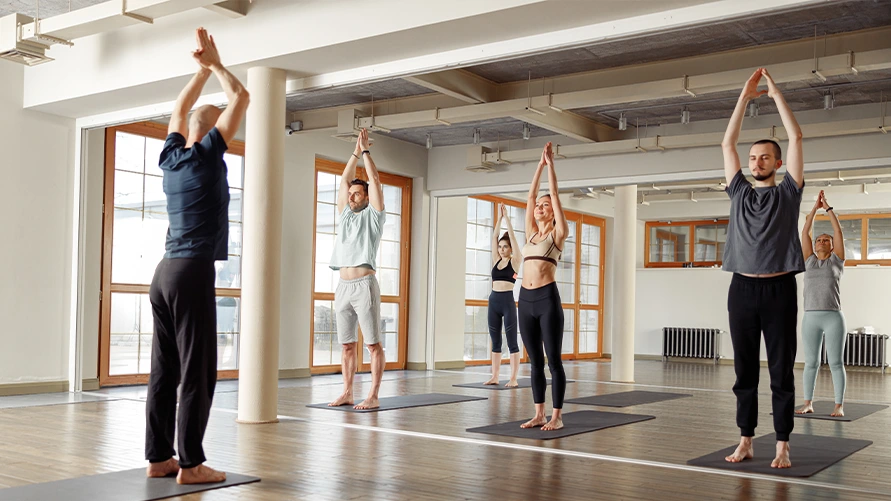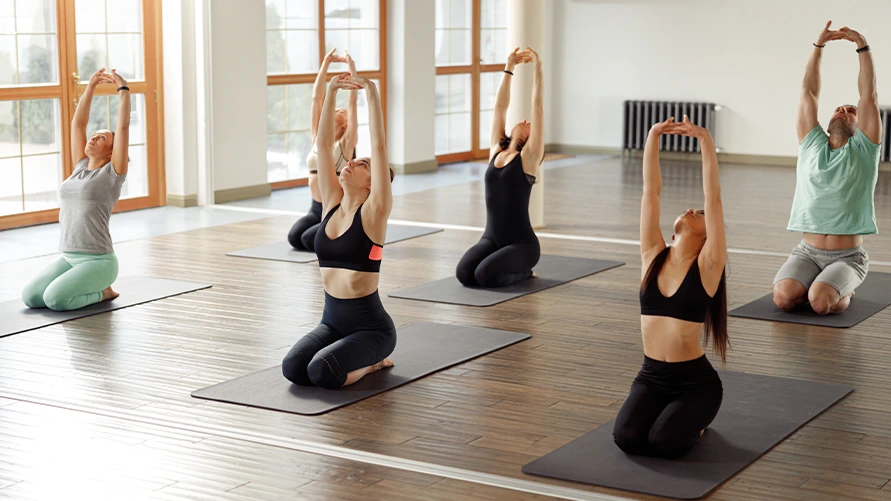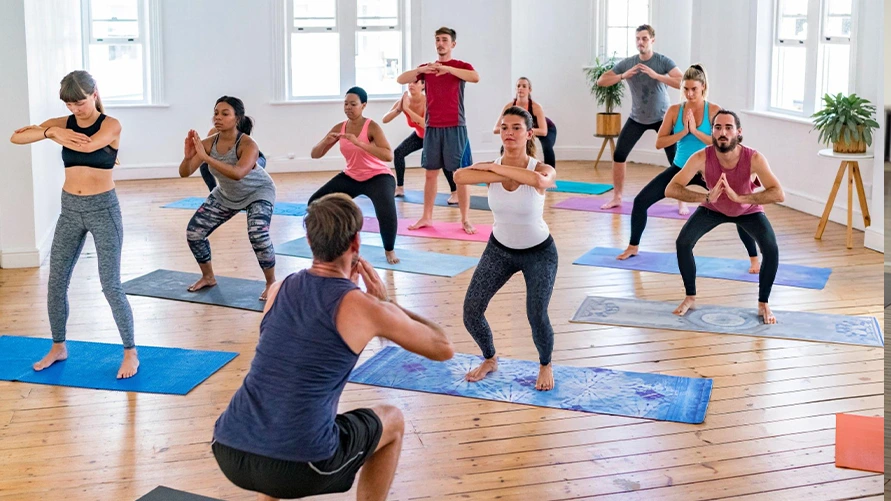Yoga has become more than just a workout. It is a lifestyle, a community, and a wellness business with staying power. For entrepreneurs, joining a yoga studio franchise offers a way to tap into this growing demand with the backing of a proven brand.
But before signing a franchise agreement, you need to understand the real costs, expected returns, contract pitfalls, and lessons learned from current owners. Here are the details you need to make a smart investment decision.

The yoga studio franchise industry at a glance
The yoga industry has matured into a multi-billion-dollar sector. Market research projects the global yoga market will exceed $66 billion by 2027. And this skyrocketing growth is due to the rise in boutique fitness and demand for stress-relief practices.
No wonder yoga attracts both practitioners and investors:
- Predictable cash flow: Most studios rely on recurring memberships rather than one-off classes.
- Customer loyalty: Yoga fosters long-term member retention.
- Scalability: Franchises provide proven models that reduce trial and error.
Not all yoga studio franchises are equal; some blend yoga with other fitness offerings to reach wider audiences.
Read more: How much does it cost to open a yoga studio?
Top yoga studio franchise opportunities in 2025
For investors and fitness entrepreneurs, these are the most profitable options:
Yoga Six
YogaSix has carved out a place in the boutique sector by making yoga accessible to a wide audience. The brand offers both heated and non-heated classes, delivered in a polished, modern studio environment.
Franchises benefit from the brand’s strong marketing campaigns and customer loyalty programs. The total investment runs between $399,370 and $462,079, including a $60,000 franchise fee. Studio owners report strong recurring revenue and one of the highest customer satisfaction scores in the category.
Hotworks
HOTWORX stands out by combining yoga with infrared fitness technology in a 24-hour studio format. Members perform yoga and isometric workouts in patented infrared saunas, giving the brand a tech-forward edge. The investment ranges from $258,500 to $580,350, depending on location.
HOTWORKS has consistently posted high average revenue per studio and appeals to customers who want convenience and results-driven wellness. Its model also reduces staffing needs, since virtual instructors guide workouts.
Barre3
Barre3 blends yoga, Pilates, and barre in a single class format that is both dynamic and community-driven. Known for its inclusive philosophy and welcoming studio culture, Barre3 has become a staple in many urban and suburban areas.
The initial investment falls between $277,033 and $552,524. Franchisees benefit from strong community retention and brand recognition in the boutique fitness market. Its hybrid format also helps attract members who want variety beyond traditional yoga.
Modo Yoga
Modo Yoga takes a more traditional approach with its hot yoga offering, but pairs it with a deep focus on sustainability and community. With more than a decade of experience, the brand has a long-standing track record in the industry.
Total investment costs range from $500,000 to $750,000, with a $50,000 franchise fee. Franchisees must have a net worth of at least $500,000, but do not need to be certified instructors themselves. Many owners highlight the strength of Modo’s training and operational support as a key advantage.
Other notable franchises
Beyond these big names, other rising options include Oxygen Yoga & Fitness, which mixes hot yoga with group fitness in infrared studios, and Hotpod Yoga, a UK-based brand expanding globally with its innovative inflatable pod studios.
Smaller but growing franchises like The Foundry Yoga and Real Hot Yoga provide more affordable entry points, often with additional real estate and setup support.

What is the real cost of opening a yoga studio franchise?
Most yoga studio franchises require $250,000 to $750,000, depending on location and brand. But while many focus on franchise fees, the total investment is what matters. And here is a breakdown of typical costs:
- Franchise fee: $40,000-$60,000 upfront.
- Build-out: Studio design, flooring, heating systems, and mirrors often cost $150,000-$300,000.
- Equipment & props: Mats, bolsters, blocks, and sound systems, typically $20,000–$40,000.
- Royalties: 6-8% of gross revenue, plus 1-3% for marketing funds.
- Working capital: At least 3-6 months of payroll, rent, and utilities.
Skipping a realistic working capital budget is the most common mistake new franchisees make—and a major reason many businesses struggle early on.
ROI and profitability: What can you expect?
Franchise brochures often paint an optimistic picture. But what does ROI really look like in a yoga studio franchise?
- Annual revenue: Most studios report between $300,000 and $600,000 once established. Some brands like HOTWORX and YogaSix boast higher averages.
- Break-even timeline: Usually 18-36 months. Urban areas with strong demand can shorten this time, while smaller markets may take longer.
- Profit margins: Once stable, net margins often land between 15-25%.
Example P&L snapshot (per year for a mid-sized studio):
- Revenue: $500,000.
- Expenses: $350,000 (staffing, rent, royalties, utilities, and marketing).
- Net profit: $150,000.
- ROI: 20-25% after year two
The ROI can be strong, but it requires careful location selection, retention strategies, and consistent marketing.
FDD red flags to watch before signing
The Franchise Disclosure Document (FDD) is your blueprint for understanding the franchise relationship. Here are the most common red flags to look for:
- Territory restrictions: If your protected zone is small, another franchise could open nearby, splitting your market.
- Vague item 19 data: This section should clearly outline financial performance. If the data is too general, ask why.
- Vendor lock-ins: Some contracts force you to buy overpriced props, flooring, or software only from approved vendors.
- Unfavorable exit clauses: Look carefully at renewal terms, transfer rules, and resale limitations.
- Advertising fund transparency: Know how your contributions are spent and whether they actually drive leads in your region.
A franchise attorney should review these details with you. Skipping this step can lock you into costly obligations.

What real franchise owners say after year one
Hearing from actual franchisees often reveals what glossy sales decks won’t tell you:
- Staffing struggles: Recruiting and keeping certified yoga instructors is a bigger challenge than expected. Many need higher pay or multiple jobs to sustain themselves.
- Retention requires work: Yoga builds loyalty, but retention still depends on smart scheduling, class variety, and customer service.
- Marketing gaps: Corporate campaigns help, but local outreach, community events, partnerships, and referral programs drive real growth.
- Cash flow reality: The first 12-18 months are usually tight. Owners often underestimate how long it takes to reach consistent profitability.
These stories underline why having both capital and patience is key to surviving the early stages.
Franchise vs. independent yoga studio
| Factor | Franchise yoga studio | Independent yoga studio |
| Upfront costs | Higher (fees + build-out) | Lower (more flexible) |
| Risk | Lower (proven system) | Higher (trial & error) |
| Brand power | Built-in recognition | Must create from scratch |
| Control | Limited (must follow rules) | Full freedom |
| Scaling | Easier with multi-unit deals | Slower, more hands-on |
A franchise offers brand strength and support, but independence offers control and creativity. Which matters more depends on your goals.
How to choose the right yoga studio franchise
When narrowing your options, don’t choose a franchise just because it looks profitable or appealing at first glance. Instead, consider what many franchisees overlook:
- Concept fit: Do you want pure yoga, or a hybrid barre/fitness model?
- Capital: Do you have enough reserves to weather 2-3 years before big profits?
- Support systems: Does the franchisor provide strong tech, training, and marketing resources?
- Culture: Does the brand’s vision match how you want to build your studio community?
Building your future in yoga
A yoga studio franchise can deliver strong profits and lasting impact, but only if you enter with clarity. The industry is thriving, yet it is not risk-free. True success requires knowing your costs, analyzing ROI, considering the FDD, and learning from current owners’ realities.
If you are serious about investing in 2025, approach the process with careful research, realistic expectations, and a long-term view. That’s how you turn yoga’s rising popularity into a sustainable business of your own.





